Christopher alexander - A pattern language
Здесь есть возможность читать онлайн «Christopher alexander - A pattern language» весь текст электронной книги совершенно бесплатно (целиком полную версию без сокращений). В некоторых случаях можно слушать аудио, скачать через торрент в формате fb2 и присутствует краткое содержание. Жанр: Прочая научная литература, на английском языке. Описание произведения, (предисловие) а так же отзывы посетителей доступны на портале библиотеки ЛибКат.
- Название:A pattern language
- Автор:
- Жанр:
- Год:неизвестен
- ISBN:нет данных
- Рейтинг книги:3 / 5. Голосов: 1
-
Избранное:Добавить в избранное
- Отзывы:
-
Ваша оценка:
- 60
- 1
- 2
- 3
- 4
- 5
A pattern language: краткое содержание, описание и аннотация
Предлагаем к чтению аннотацию, описание, краткое содержание или предисловие (зависит от того, что написал сам автор книги «A pattern language»). Если вы не нашли необходимую информацию о книге — напишите в комментариях, мы постараемся отыскать её.
A pattern language — читать онлайн бесплатно полную книгу (весь текст) целиком
Ниже представлен текст книги, разбитый по страницам. Система сохранения места последней прочитанной страницы, позволяет с удобством читать онлайн бесплатно книгу «A pattern language», без необходимости каждый раз заново искать на чём Вы остановились. Поставьте закладку, и сможете в любой момент перейти на страницу, на которой закончили чтение.
Интервал:
Закладка:
• * *
V V V
If a garden is too close to the street, people won’t use it because it isn’t private enough. But if it is too far from the street, then it won’t be used either, because it is too isolated.
Start by thinking about the front gardens which you know. They are often decorative, lawns, flowers. But how often are people sitting there? Except at those special moments, when people want specifically to be watching the street, the front garden is nothing but a decoration. The half-private family groups, drinks with friends, playing ball with the children, lying in the grass—these need more protection than the typical front garden can create.
And the back gardens do not really solve the problem either. Those back gardens which are entirely isolated, entirely “in back” —are so remote from the street, that people often don’t feel comfortable there either. Often the back garden is so remote from the street, that you can’t hear people coming to the house; you have no sense of any larger, more open space, no sense of other people—only the enclosed, isolated, fenced-in world of one family. Children, so much more spontaneous and intuitive, give us a view in microcosm. How rarely they play in the full back garden; how much more often they prefer these side yards and gardens which have some privacy, yet also some exposure to the street.
within each region work toward those regional policies which will -protect the land and mark the limits of the cities:
2. THE DISTRIBUTION OF TOWNS
3. CITY COUNTRY FINGERS
4. AGRICULTURAL VALLEYS
5. LACE OF COUNTRY STREETS
6. COUNTRY TOWNS
7. THE COUNTRYSIDE
15
BUILDINGS
It seems then, that the proper place for a garden is neither in front, nor fully behind. The garden needs a certain degree of privacy, yet also wants some kind of tenuous connection to the street and entrance. This balance can only be created in a situation where the garden is half in front, half in back—in a word, at the side, protected by a wall from too great an exposure to the street; and yet open enough, through paths, gates, arcades, trellises, so that people in the garden still have a glimpse of the street, a view of the front door or the path to the front door.
All this requires a revolution in the normal conception of a “lot.” Lots are usually narrow along the street and deep. But to create half-hidden gardens, the lots must be long along the street, and shallow, so that each house can have a garden at its side. This gives the following archetype for house and half-hidden.
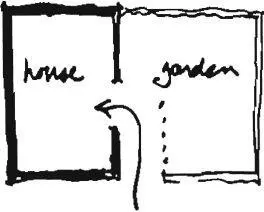 |
| Archetyfe of a half-hidden garden. |
There are many ways of developing this idea. One version we experienced in an old house where we once had our offices was particularly interesting.
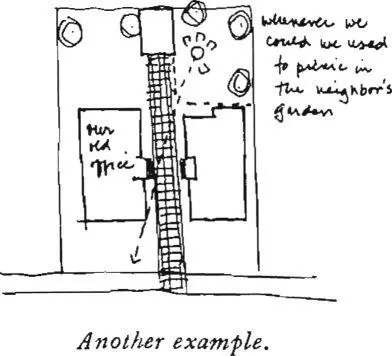
546
Ill HALF-HIDDEN GARDEN
The garden that we used was to the back, but behind the next-door house. It worked perfectly as a half-hidden garden for our house. We were able to sit there privately and have our lunch, and work on warm days, and still be in touch with the main entrance and even a glimpse of the street. But our own back garden was entirely hidden—and we never used it.
Therefore:
Do not place the garden fully in front of the house, nor fully to the back. Instead, place it in some kind of half-way position, side-by-side with the house, in a position which is half-hidden from the street, and half-exposed.
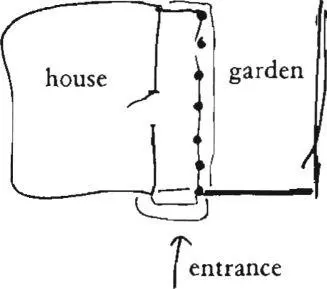
If possible, use this pattern to influence the shape of house lots too, and make them as near double squares along the street as possible; build a partial wall around the garden, and locate the entrance to the house between the house and the garden, so that people in the garden can be private, yet still aware of the street, and aware of anybody coming up to the house—main entrance (iio), Carden wall (I 7 3) ; allow the garden to grow wild— garden growing wild (172), and make the passage through, or alongside it, a major part of the transition between street and house—entrance transition (I i 2). Half-hidden gardens may be courtyards which live (115), roof gardens ( i 18), or a private terrace on the street (140). . . .
| I 12 ENTRANCE TRANSITION** |
|---|
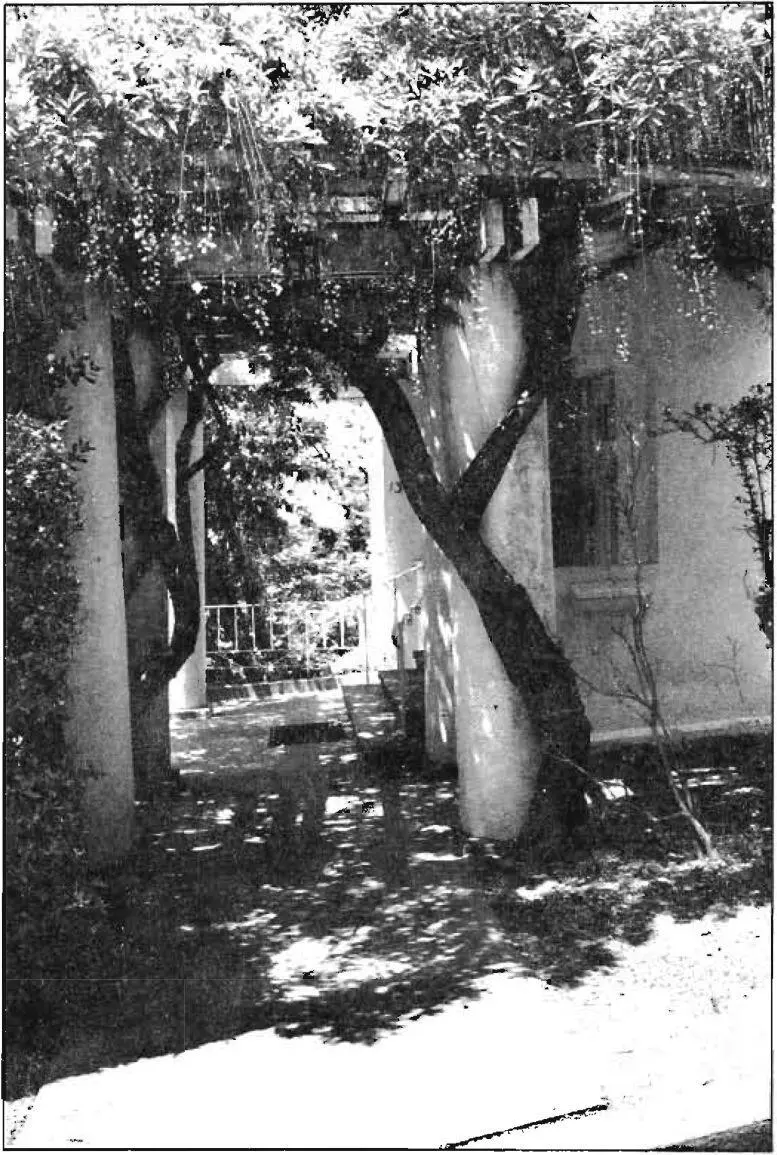 |
. . . whatever kind of building or building complex you are making, you have a rough position for its major entrances—the gateways to the site from main gateways (53) ; the entrances to individual buildings from family of entrances (102), main entrance (110). In every case, the entrances create a transition between the “outside”—the public world—and some less public inner world. If you have half-hidden gardens (ill) the gardens help to intensify the beauty of the transition. This pattern now elaborates and reinforces the transition which entrances and gardens generate.
Buildings, and especially houses, with a graceful transition between the street and the inside, are more tranquil than those which open directly off the street.
The experience of entering a building influences the way you feel inside the building. If the transition is too abrupt there is no feeling of arrival, and the inside of the building fails to be an inner sanctum.
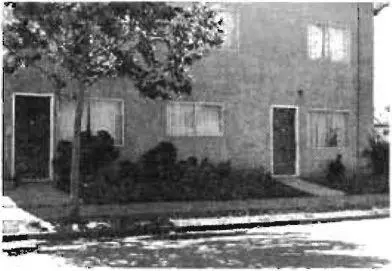 |
| An abrupt entrance—no transition. |
The following argument may help to explain it. While people are on the street, they adopt a style of “street behavior.” When they come into a house they naturally want to get rid of this street behavior and settle down completely into the more intimate spirit appropriate to a house. But it seems likely that they cannot do this unless there is a transition from one to the other which
BUILDINGS
helps them to lose the street behavior. The transition must, in effect, destroy the momentum of the closedness, tension and “distance” which are appropriate to street behavior, before people can relax completely.
Evidence comes from the report by Robert Weiss and Serge Boutcrline, Fairs , Exhibits , Pavilions , and their Audiences , Cambridge, Mass., 1962. The authors noticed that many exhibits failed to “hold” people; people drifted in and then drifted out again within a very short time. However, in one exhibit people had to cross a huge, deep-pile, bright orange carpet on the way in. In this case, though the exhibit was no better than other exhibits, people stayed. The authors concluded that people were, in general, under the influence of their own “street and crowd behavior,” and that while under this influence could not relax enough to make contact with the exhibits. But the bright carpet presented them with such a strong contrast as they walked in, that it broke the effect of their outside behavior, in effect “wiped them clean,” with the result that they could then get absorbed in the exhibit.
Читать дальшеИнтервал:
Закладка:
Похожие книги на «A pattern language»
Представляем Вашему вниманию похожие книги на «A pattern language» списком для выбора. Мы отобрали схожую по названию и смыслу литературу в надежде предоставить читателям больше вариантов отыскать новые, интересные, ещё непрочитанные произведения.
Обсуждение, отзывы о книге «A pattern language» и просто собственные мнения читателей. Оставьте ваши комментарии, напишите, что Вы думаете о произведении, его смысле или главных героях. Укажите что конкретно понравилось, а что нет, и почему Вы так считаете.












